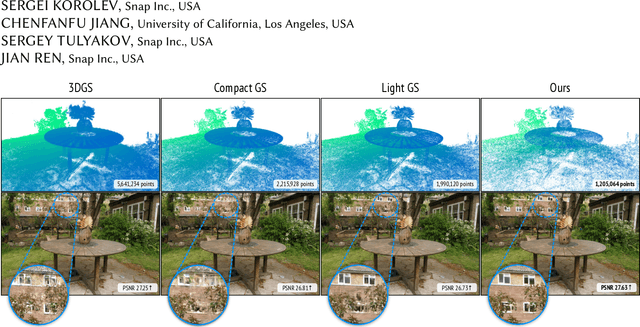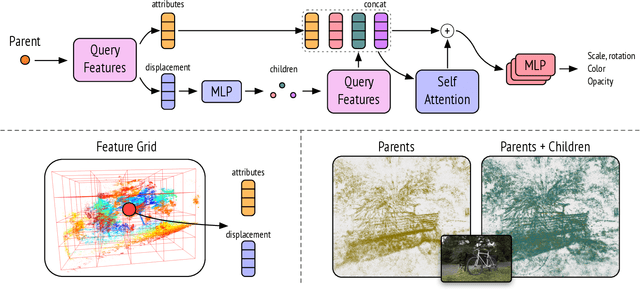Chenfanfu Jiang
Articulated Kinematics Distillation from Video Diffusion Models
Apr 01, 2025Abstract:We present Articulated Kinematics Distillation (AKD), a framework for generating high-fidelity character animations by merging the strengths of skeleton-based animation and modern generative models. AKD uses a skeleton-based representation for rigged 3D assets, drastically reducing the Degrees of Freedom (DoFs) by focusing on joint-level control, which allows for efficient, consistent motion synthesis. Through Score Distillation Sampling (SDS) with pre-trained video diffusion models, AKD distills complex, articulated motions while maintaining structural integrity, overcoming challenges faced by 4D neural deformation fields in preserving shape consistency. This approach is naturally compatible with physics-based simulation, ensuring physically plausible interactions. Experiments show that AKD achieves superior 3D consistency and motion quality compared with existing works on text-to-4D generation. Project page: https://research.nvidia.com/labs/dir/akd/
GRIP: A General Robotic Incremental Potential Contact Simulation Dataset for Unified Deformable-Rigid Coupled Grasping
Mar 06, 2025Abstract:Grasping is fundamental to robotic manipulation, and recent advances in large-scale grasping datasets have provided essential training data and evaluation benchmarks, accelerating the development of learning-based methods for robust object grasping. However, most existing datasets exclude deformable bodies due to the lack of scalable, robust simulation pipelines, limiting the development of generalizable models for compliant grippers and soft manipulands. To address these challenges, we present GRIP, a General Robotic Incremental Potential contact simulation dataset for universal grasping. GRIP leverages an optimized Incremental Potential Contact (IPC)-based simulator for multi-environment data generation, achieving up to 48x speedup while ensuring efficient, intersection- and inversion-free simulations for compliant grippers and deformable objects. Our fully automated pipeline generates and evaluates diverse grasp interactions across 1,200 objects and 100,000 grasp poses, incorporating both soft and rigid grippers. The GRIP dataset enables applications such as neural grasp generation and stress field prediction.
A Convex Formulation of Material Points and Rigid Bodies with GPU-Accelerated Async-Coupling for Interactive Simulation
Mar 06, 2025Abstract:We present a novel convex formulation that weakly couples the Material Point Method (MPM) with rigid body dynamics through frictional contact, optimized for efficient GPU parallelization. Our approach features an asynchronous time-splitting scheme to integrate MPM and rigid body dynamics under different time step sizes. We develop a globally convergent quasi-Newton solver tailored for massive parallelization, achieving up to 500x speedup over previous convex formulations without sacrificing stability. Our method enables interactive-rate simulations of robotic manipulation tasks with diverse deformable objects including granular materials and cloth, with strong convergence guarantees. We detail key implementation strategies to maximize performance and validate our approach through rigorous experiments, demonstrating superior speed, accuracy, and stability compared to state-of-the-art MPM simulators for robotics. We make our method available in the open-source robotics toolkit, Drake.
Towards Physical Understanding in Video Generation: A 3D Point Regularization Approach
Feb 05, 2025Abstract:We present a novel video generation framework that integrates 3-dimensional geometry and dynamic awareness. To achieve this, we augment 2D videos with 3D point trajectories and align them in pixel space. The resulting 3D-aware video dataset, PointVid, is then used to fine-tune a latent diffusion model, enabling it to track 2D objects with 3D Cartesian coordinates. Building on this, we regularize the shape and motion of objects in the video to eliminate undesired artifacts, \eg, nonphysical deformation. Consequently, we enhance the quality of generated RGB videos and alleviate common issues like object morphing, which are prevalent in current video models due to a lack of shape awareness. With our 3D augmentation and regularization, our model is capable of handling contact-rich scenarios such as task-oriented videos. These videos involve complex interactions of solids, where 3D information is essential for perceiving deformation and contact. Furthermore, our model improves the overall quality of video generation by promoting the 3D consistency of moving objects and reducing abrupt changes in shape and motion.
Dress-1-to-3: Single Image to Simulation-Ready 3D Outfit with Diffusion Prior and Differentiable Physics
Feb 05, 2025



Abstract:Recent advances in large models have significantly advanced image-to-3D reconstruction. However, the generated models are often fused into a single piece, limiting their applicability in downstream tasks. This paper focuses on 3D garment generation, a key area for applications like virtual try-on with dynamic garment animations, which require garments to be separable and simulation-ready. We introduce Dress-1-to-3, a novel pipeline that reconstructs physics-plausible, simulation-ready separated garments with sewing patterns and humans from an in-the-wild image. Starting with the image, our approach combines a pre-trained image-to-sewing pattern generation model for creating coarse sewing patterns with a pre-trained multi-view diffusion model to produce multi-view images. The sewing pattern is further refined using a differentiable garment simulator based on the generated multi-view images. Versatile experiments demonstrate that our optimization approach substantially enhances the geometric alignment of the reconstructed 3D garments and humans with the input image. Furthermore, by integrating a texture generation module and a human motion generation module, we produce customized physics-plausible and realistic dynamic garment demonstrations. Project page: https://dress-1-to-3.github.io/
PhysAnimator: Physics-Guided Generative Cartoon Animation
Jan 27, 2025Abstract:Creating hand-drawn animation sequences is labor-intensive and demands professional expertise. We introduce PhysAnimator, a novel approach for generating physically plausible meanwhile anime-stylized animation from static anime illustrations. Our method seamlessly integrates physics-based simulations with data-driven generative models to produce dynamic and visually compelling animations. To capture the fluidity and exaggeration characteristic of anime, we perform image-space deformable body simulations on extracted mesh geometries. We enhance artistic control by introducing customizable energy strokes and incorporating rigging point support, enabling the creation of tailored animation effects such as wind interactions. Finally, we extract and warp sketches from the simulation sequence, generating a texture-agnostic representation, and employ a sketch-guided video diffusion model to synthesize high-quality animation frames. The resulting animations exhibit temporal consistency and visual plausibility, demonstrating the effectiveness of our method in creating dynamic anime-style animations.
PhysMotion: Physics-Grounded Dynamics From a Single Image
Nov 26, 2024Abstract:We introduce PhysMotion, a novel framework that leverages principled physics-based simulations to guide intermediate 3D representations generated from a single image and input conditions (e.g., applied force and torque), producing high-quality, physically plausible video generation. By utilizing continuum mechanics-based simulations as a prior knowledge, our approach addresses the limitations of traditional data-driven generative models and result in more consistent physically plausible motions. Our framework begins by reconstructing a feed-forward 3D Gaussian from a single image through geometry optimization. This representation is then time-stepped using a differentiable Material Point Method (MPM) with continuum mechanics-based elastoplasticity models, which provides a strong foundation for realistic dynamics, albeit at a coarse level of detail. To enhance the geometry, appearance and ensure spatiotemporal consistency, we refine the initial simulation using a text-to-image (T2I) diffusion model with cross-frame attention, resulting in a physically plausible video that retains intricate details comparable to the input image. We conduct comprehensive qualitative and quantitative evaluations to validate the efficacy of our method. Our project page is available at: \url{https://supertan0204.github.io/physmotion_website/}.
ARM: Appearance Reconstruction Model for Relightable 3D Generation
Nov 16, 2024Abstract:Recent image-to-3D reconstruction models have greatly advanced geometry generation, but they still struggle to faithfully generate realistic appearance. To address this, we introduce ARM, a novel method that reconstructs high-quality 3D meshes and realistic appearance from sparse-view images. The core of ARM lies in decoupling geometry from appearance, processing appearance within the UV texture space. Unlike previous methods, ARM improves texture quality by explicitly back-projecting measurements onto the texture map and processing them in a UV space module with a global receptive field. To resolve ambiguities between material and illumination in input images, ARM introduces a material prior that encodes semantic appearance information, enhancing the robustness of appearance decomposition. Trained on just 8 H100 GPUs, ARM outperforms existing methods both quantitatively and qualitatively.
Embedded IPC: Fast and Intersection-free Simulation in Reduced Subspace for Robot Manipulation
Sep 24, 2024



Abstract:Physics-based simulation is essential for developing and evaluating robot manipulation policies, particularly in scenarios involving deformable objects and complex contact interactions. However, existing simulators often struggle to balance computational efficiency with numerical accuracy, especially when modeling deformable materials with frictional contact constraints. We introduce an efficient subspace representation for the Incremental Potential Contact (IPC) method, leveraging model reduction to decrease the number of degrees of freedom. Our approach decouples simulation complexity from the resolution of the input model by representing elasticity in a low-resolution subspace while maintaining collision constraints on an embedded high-resolution surface. Our barrier formulation ensures intersection-free trajectories and configurations regardless of material stiffness, time step size, or contact severity. We validate our simulator through quantitative experiments with a soft bubble gripper grasping and qualitative demonstrations of placing a plate on a dish rack. The results demonstrate our simulator's efficiency, physical accuracy, computational stability, and robust handling of frictional contact, making it well-suited for generating demonstration data and evaluating downstream robot training applications.
Lightweight Predictive 3D Gaussian Splats
Jun 27, 2024



Abstract:Recent approaches representing 3D objects and scenes using Gaussian splats show increased rendering speed across a variety of platforms and devices. While rendering such representations is indeed extremely efficient, storing and transmitting them is often prohibitively expensive. To represent large-scale scenes, one often needs to store millions of 3D Gaussians, occupying gigabytes of disk space. This poses a very practical limitation, prohibiting widespread adoption.Several solutions have been proposed to strike a balance between disk size and rendering quality, noticeably reducing the visual quality. In this work, we propose a new representation that dramatically reduces the hard drive footprint while featuring similar or improved quality when compared to the standard 3D Gaussian splats. When compared to other compact solutions, ours offers higher quality renderings with significantly reduced storage, being able to efficiently run on a mobile device in real-time. Our key observation is that nearby points in the scene can share similar representations. Hence, only a small ratio of 3D points needs to be stored. We introduce an approach to identify such points which are called parent points. The discarded points called children points along with attributes can be efficiently predicted by tiny MLPs.
 Add to Chrome
Add to Chrome Add to Firefox
Add to Firefox Add to Edge
Add to Edge